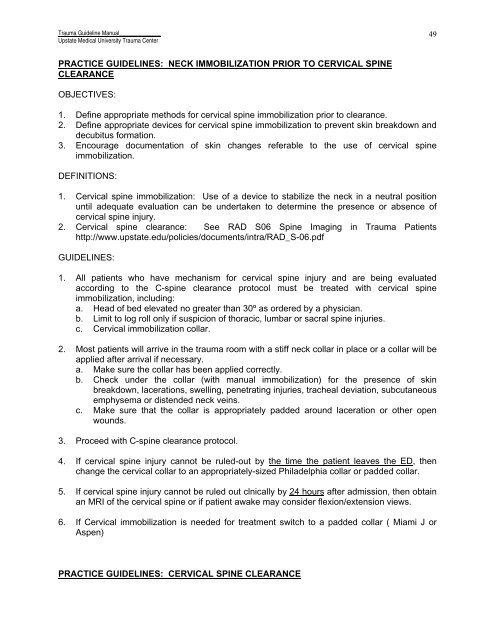Trauma Guideline Manual - SUNY Upstate Medical University
Trauma Guideline Manual - SUNY Upstate Medical University
Trauma Guideline Manual - SUNY Upstate Medical University
Create successful ePaper yourself
Turn your PDF publications into a flip-book with our unique Google optimized e-Paper software.
<strong>Trauma</strong> <strong>Guideline</strong> <strong>Manual</strong>______________<strong>Upstate</strong> <strong>Medical</strong> <strong>University</strong> <strong>Trauma</strong> Center49PRACTICE GUIDELINES: NECK IMMOBILIZATION PRIOR TO CERVICAL SPINECLEARANCEOBJECTIVES:1. Define appropriate methods for cervical spine immobilization prior to clearance.2. Define appropriate devices for cervical spine immobilization to prevent skin breakdown anddecubitus formation.3. Encourage documentation of skin changes referable to the use of cervical spineimmobilization.DEFINITIONS:1. Cervical spine immobilization: Use of a device to stabilize the neck in a neutral positionuntil adequate evaluation can be undertaken to determine the presence or absence ofcervical spine injury.2. Cervical spine clearance: See RAD S06 Spine Imaging in <strong>Trauma</strong> Patientshttp://www.upstate.edu/policies/documents/intra/RAD_S-06.pdfGUIDELINES:1. All patients who have mechanism for cervical spine injury and are being evaluatedaccording to the C-spine clearance protocol must be treated with cervical spineimmobilization, including:a. Head of bed elevated no greater than 30º as ordered by a physician.b. Limit to log roll only if suspicion of thoracic, lumbar or sacral spine injuries.c. Cervical immobilization collar.2. Most patients will arrive in the trauma room with a stiff neck collar in place or a collar will beapplied after arrival if necessary.a. Make sure the collar has been applied correctly.b. Check under the collar (with manual immobilization) for the presence of skinbreakdown, lacerations, swelling, penetrating injuries, tracheal deviation, subcutaneousemphysema or distended neck veins.c. Make sure that the collar is appropriately padded around laceration or other openwounds.3. Proceed with C-spine clearance protocol.4. If cervical spine injury cannot be ruled-out by the time the patient leaves the ED, thenchange the cervical collar to an appropriately-sized Philadelphia collar or padded collar.5. If cervical spine injury cannot be ruled out clnically by 24 hours after admission, then obtainan MRI of the cervical spine or if patient awake may consider flexion/extension views.6. If Cervical immobilization is needed for treatment switch to a padded collar ( Miami J orAspen)PRACTICE GUIDELINES: CERVICAL SPINE CLEARANCE
















